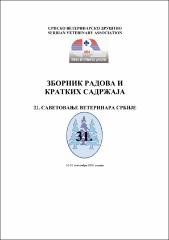Primena Next generation Sequencing (NGS) za sekvenciranje SARS-COV-2 virusa u VSI Kraljevo

View/
Date
2020-09Author
Vidanović, Dejan
Tešović, Bojana
Šekler, Milanko
Dmitrić, Marko
Matović, Kazimir
Debeljak, Zoran
Vasković, Nikola
Petrović, Tamaš
Banović Đeri, Bojana
Kolarević, Mišo
Metadata
Show full item recordAbstract
The new Betacoronavirus "severe acute respiratory syndrome coronavirus 2" (SARS-CoV-2) appeared at the end of 2019 in China and very quickly spread to the rest of the world in the form of a pandemic. In Serbia, the first case of people contracting the virus was recorded on March 6, 2020. The Health Service of the Republic of Serbia has mobilized all its capacities to respond to this pandemic. In order to increase the number of PCR tests, the Government of the Republic of Serbia also included NIV "Novi Sad", VSI "Kraljevo", VSI "Niš" and "VSI "Šabac" in the chain of laboratories that tested samples of human origin.
Since the beginning of the pandemic, a large number of countries in the world have published sequences of the entire genome of the SARS-CoV-2 virus. Sequencing of the whole genome is necessary in order to obtain very important information about the origin and similarity with other viruses, ways of introduction into the country, ways of spreading, the rate of mutation through space and time and the possible impact of these mutations on virus virulence. Realizing the importance of sequencing the entire genome, the virology laboratory VSI "Kraljevo", in addition to daily testing of a large number of samples, managed to be the first in the country to sequence the entire genome of the SARS-CoV-2 virus.
Sequencing of the entire genome was performed on selected clinical samples of human oropharyngeal swabs based on a protocol developed by the Artic Network group. RNA was extracted from the samples and immediately translated into cDNA which was further amplified in a multiplex PCR reaction. From the obtained fragments, libraries for NGS sequencing were made on a Minion device (Oxford Nanopore). The obtained data were processed with bioinformatics programs recommended by the Artic Network group.
As a result of sequencing, 25 complete genomes of SARS-CoV-2 virus were obtained. The sequences are stored in GeneBank and GISAID databases and are available for further analysis to the world scientific community. Further sequencing of a number of SARS-CoV-2 virus samples is underway and the obtained results will be analyzed as part of the project of the Medical Faculty in Belgrade entitled "National study of seroprevalence and molecular characterization of SARS-CoV-2 during an epidemic in the Serbian population" approved and financed by the Government of the Republic of Serbia.
The sequencing methodology and bioinformatics of data processing implemented for sequencing of SARS-CoV-2 virus in VSI "Kraljevo" represents a big step forward in the diagnostic capacities not only of VSI "Kraljevo" but also of the entire veterinary service in the country, because the NGS technology was applied for the first time. This technology, with certain modifications, can be applied and is already being applied in VSI Kraljevo for sequencing other viruses important not only for human health but also for animal health.
